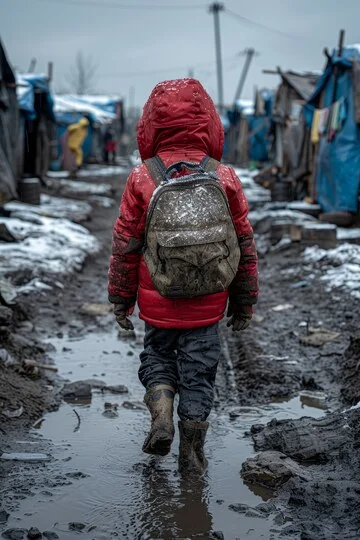Introduction: The ‘Third Pole’ and Its Global Significance
The Himalayas, often called the “Third Pole” due to their massive reserve of glaciers, play a vital role in South Asia’s climate, water resources, and biodiversity. They are home to around 15,000 glaciers, which feed into major rivers supporting nearly 1.6 billion people. The region’s importance is not just local; its climate impacts resonate globally, affecting ecosystems and weather patterns far beyond South Asia. However, climate change is bringing unprecedented challenges to the Himalayas, and understanding these challenges is crucial for both regional and global sustainability.
Understanding Climate Challenges in the Himalayas
The Himalayas face unique climate issues, largely driven by global warming and human activity. Here are the primary challenges:
- Melting Glaciers: Rising temperatures cause Himalayan glaciers to melt faster, reducing ice reserves. According to a study, Himalayan glaciers have shrunk by 27% over the last 40 years. This decline endangers rivers like the Ganges and the Indus, vital water sources for agriculture and drinking water across South Asia.
- Changing Weather Patterns: Climate change is leading to unpredictable monsoon patterns, which disrupt agricultural cycles and can cause extreme weather events, such as floods and droughts. For communities that rely heavily on seasonal rainfall, these shifts threaten food security and livelihoods.
- Impact on Biodiversity: The Himalayas are home to diverse ecosystems and endangered species like the snow leopard. Warmer temperatures disrupt these habitats, forcing species to higher altitudes or threatening them with extinction.
- Threat to Local Communities: Communities relying on traditional farming and livestock face threats due to changing land conditions and water shortages. The increased occurrence of natural disasters such as landslides and floods due to melting glaciers also endangers lives and homes.
Table: Key Climate Challenges in the Himalayas
| Challenge | Description | Impact Area |
| Melting Glaciers | Faster melting reduces river water supplies | Agriculture, Water Supply |
| Changing Weather Patterns | Unpredictable rainfall leads to floods, droughts | Food Security, Livelihoods |
| Impact on Biodiversity | Habitat changes threaten species survival | Ecosystems, Wildlife |
| Community Threats | Livelihoods at risk due to environmental changes | Local Populations |
The Impact of Climate Change on Communities and Ecosystems
The communities in the Himalayan region are deeply intertwined with nature, relying on it for agriculture, livestock, and even cultural practices. Climate change impacts both directly and indirectly:
- Agricultural Disruptions: With erratic rainfall and shifting growing seasons, farmers struggle to predict planting and harvesting periods, leading to crop losses. Crops that once thrived in certain regions are now failing, impacting local economies.
- Natural Disasters: Landslides and flash floods, fueled by melting glaciers, are increasingly common. These events not only damage property but can displace entire communities. The changing landscape makes some areas permanently unsafe, leading to forced migrations.
- Health Risks: Warmer temperatures bring diseases like malaria to higher altitudes, exposing previously unaffected communities to new health threats.
South Asia’s Collaborative Efforts in Climate Action
Recognizing the need for collaboration, South Asian countries are increasingly working together to tackle these climate issues. Key collaborative actions include:
- Bilateral and Multilateral Agreements: Countries like India, Nepal, Bhutan, and Bangladesh are part of treaties that encourage sharing climate data, especially for glacier monitoring and disaster response. This cooperation helps build resilience across borders.
- Research Initiatives: Organizations like the International Centre for Integrated Mountain Development (ICIMOD) bring together researchers from across South Asia to study glacier health, water resources, and climate resilience. Such efforts help in forming policies based on scientific evidence.
- Joint Conservation Efforts: South Asian countries collaborate on conservation projects for endangered species. Protecting species like the snow leopard also means preserving their fragile habitats.
- Early Warning Systems: Some areas now have systems to warn about impending floods, which helps communities evacuate in time. These systems rely on cross-border data sharing and regional cooperation.
Technological Innovations and Local Solutions for Climate Adaptation
Technological advancements play a critical role in helping the Himalayas adapt to climate change. Here’s how technology and local efforts contribute:
- Early Warning Systems: Countries are implementing weather forecasting and early warning systems, especially for floods and landslides. These systems allow timely evacuations and can save lives in disaster-prone areas.
- Sustainable Agriculture: Local farmers are being encouraged to adopt practices like rainwater harvesting, terrace farming, and crop rotation. These techniques make agriculture more resilient to changing weather and help conserve water.
- Renewable Energy Projects: Hydropower, solar energy, and wind power projects in the Himalayan region reduce reliance on fossil fuels and provide clean energy options. By utilizing natural resources sustainably, these initiatives reduce the region’s overall carbon footprint.
- Community-Led Conservation: Locals are often the best stewards of their land. Programs that involve local communities in reforestation, river conservation, and sustainable tourism have shown positive impacts. Community-based conservation projects ensure that people living in the Himalayas have a say in the protection and management of their environment.
Challenges to Regional Climate Policies and Implementation
Despite regional cooperation, significant challenges hinder effective climate action:
- Political Tensions: Border disputes between countries sometimes make collaboration difficult. Even minor political conflicts can delay joint environmental projects.
- Funding Constraints: Many South Asian countries struggle with financial resources to implement large-scale climate programs. International funding is often required, which can be inconsistent and difficult to secure.
- Infrastructural Gaps: The Himalayan region’s remote and rugged terrain makes infrastructure development costly and challenging. Without infrastructure, implementing technological solutions or disaster response systems becomes much harder.
- Public Awareness: Climate education in rural areas remains limited, reducing the impact of initiatives that require community involvement. Awareness campaigns are essential but often lack sufficient funding and support.
Future Outlook: The Path Forward for the ‘Third Pole’
The future of the Himalayas depends on a balanced mix of conservation, collaboration, and innovation. Regional and international partnerships, increased funding, and sustainable practices are key to ensuring that future generations can benefit from the Himalayas. If South Asia continues to make climate a priority, the Third Pole can be preserved for future generations. This path forward requires long-term vision and proactive adaptation measures to stay ahead of climate-related challenges.
Conclusion: Global Responsibility to Protect the Himalayas
The Himalayas’ well-being is a global concern. The region’s water resources, biodiversity, and climate stability are essential for the health of our planet. Therefore, while South Asian countries must lead in protecting the Himalayas, international support is crucial. Climate change knows no borders, and neither should efforts to combat it. Protecting the Himalayas requires a global commitment to sustainability, technological aid, and financial support.
FAQs
- Why are the Himalayas called the ‘Third Pole’?
- The Himalayas are referred to as the ‘Third Pole’ because they contain the largest reserve of ice outside the polar regions, holding around 15,000 glaciers that play a crucial role in Asia’s water supply.
- How is climate change affecting Himalayan glaciers?
- Climate change is causing glaciers in the Himalayas to melt rapidly, which reduces the ice reserve and threatens major rivers like the Ganges, impacting water supply for millions.
- What are the key environmental challenges in the Himalayas?
- Key challenges include glacier melting, unpredictable weather patterns, biodiversity loss, and threats to communities from natural disasters like floods and landslides.
- How are South Asian countries addressing climate challenges in the Himalayas?
- South Asian countries are working together through agreements, research initiatives, conservation projects, and early warning systems to address climate issues collaboratively.
- What role does technology play in protecting the Himalayas?
- Technology, such as early warning systems, sustainable agriculture techniques, and renewable energy projects, helps make the region more resilient to climate impacts and reduces carbon emissions.
- Can community involvement make a difference in conservation efforts?
- Yes, community-led initiatives, like sustainable tourism and reforestation projects, are vital for effective conservation, as locals have invaluable knowledge and a vested interest in protecting their environment.
- How can the global community help in protecting the Himalayas?
- The global community can support South Asia by providing funding, technological assistance, and partnerships to implement large-scale climate resilience projects in the Himalayan region.


